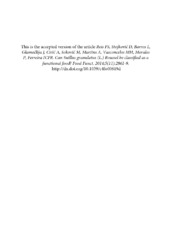Приказ основних података о документу
Can Suillus granulatus (L.) Roussel be classified as a functional food?
| dc.creator | Reis, Filipa S. | |
| dc.creator | Stojković, Dejan | |
| dc.creator | Barros, Lillian | |
| dc.creator | Glamočlija, Jasmina | |
| dc.creator | Ćirić, Ana | |
| dc.creator | Soković, Marina | |
| dc.creator | Martins, Anabela | |
| dc.creator | Vasconcelos, M. Helena | |
| dc.creator | Morales, Patricia | |
| dc.creator | Ferreira, Isabel C. F. R. | |
| dc.date | 2015-09-01 | |
| dc.date.accessioned | 2016-05-23T11:00:18Z | |
| dc.date.accessioned | 2019-11-04T10:50:23Z | |
| dc.date.available | 2019-11-04T10:50:23Z | |
| dc.date.issued | 2014 | |
| dc.identifier.issn | 2042-650X | |
| dc.identifier.uri | https://radar.ibiss.bg.ac.rs/handle/123456789/2129 | |
| dc.identifier.uri | https://radar.ibiss.bg.ac.rs/handle/123456789/3493 | |
| dc.description.abstract | The present work outlines a detailed chemical characterization of Suillus granulatus species, besides presenting the antioxidant and antimicrobial properties of their methanolic extracts. The study was carried out with samples drawn from Portugal and Serbia in order to prove that though mushrooms are strongly influenced by the environment in which they develop, they have a specific chemical profile that can be typical of their genus/species. The studied species proved to be healthy foods, low in fat and rich in protein and carbohydrates, with mannitol and trehalose being the main free sugars detected. They also proved to be a source of organic and phenolic acids, as well as mono- and polyunsaturated fatty acids and tocopherols. The Serbian samples revealed higher antioxidant and antimicrobial potential. Accordingly, we find that the S. granulatus species can be considered to be a functional food, since it is a source of nutraceutical and biologically active compounds. | en |
| dc.description.sponsorship | Foundation for Science and Technology (FCT, Portugal); COMPETE/QREN/EU {[}PEst-OE/AGR/UI0690/2011]; Serbian Ministry of Education, Science and Technological Development {[}173032] | |
| dc.language | English | |
| dc.relation | info:eu-repo/grantAgreement/MESTD/Basic Research (BR or ON)/173032/RS// | |
| dc.relation | PEst-OE/AGR/UI0690/2011 | |
| dc.rights | embargoedAccess | |
| dc.source | Food & Function | |
| dc.title | Can Suillus granulatus (L.) Roussel be classified as a functional food? | en |
| dc.type | article | |
| dc.rights.license | ARR | |
| dcterms.abstract | Гламочлија, Јасмина; Ферреира, Исабел Ц. Ф. Р.; Моралес, Патрициа; Васцонцелос, М. Хелена; Мартинс, Aнабела; Соковић, Марина; Ћирић, Aна; Реис, Филипа С.; Стојковић, Дејан; Баррос, Лиллиан; Цан Суиллус гранулатус (Л.) Роуссел бе цлассифиед ас а фунцтионал фоод?; | |
| dc.rights.holder | © The Royal Society of Chemistry 2014 | |
| dc.citation.issue | 11 | |
| dc.citation.volume | 5 | |
| dc.description.note | This is the accepted version of the article Reis FS, Stojković D, Barros L, Glamočlija J, Cirić A, Soković M, Martins A, Vasconcelos MH, Morales P, Ferreira ICFR. Can Suillus granulatus (L.) Roussel be classified as a functional food? Food Funct. 2014;5(11):2861-9. [http://dx.doi.org/10.1039/c4fo00619d] | |
| dc.identifier.doi | 10.1039/c4fo00619d | |
| dc.identifier.scopus | 2-s2.0-84908131518 | |
| dc.identifier.wos | 000344320600017 | |
| dc.citation.spage | 2861 | |
| dc.citation.epage | 2869 | |
| dc.type.version | acceptedVersion | en |
| dc.identifier.fulltext | https://radar.ibiss.bg.ac.rs/bitstream/id/5497/231.pdf | |
| dc.citation.rank | M21 |

